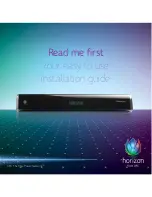
ENGLISH
5
CAUTION:
1. Moving components such as mounting brackets may become jammed.
2. In the case of devices with motor-driven components, there is a risk of injury due to the movement of the device. Sudden
movement of the device can cause shock reactions.
3. The housing surface of the device can become very hot during regular operation. Ensure that accidental touching of the
housing is not possible. Always allow the device to cool down sufficiently before removal, maintenance work and charging
etc.
CAUTION:
1. Do not install or use the device in the vicinity of radiators, accumulators, stoves, or other heat sources Ensure that the
device is always installed in such a way that it is sufficiently cooled and cannot overheat.
2. Do not place ignition sources, such as burning candles, near the device.
3. Ventilation openings must not be covered and fans must not be blocked.
4. Use the original packaging or packaging provided by the manufacturer for transport.
5. Avoid shocks or impacts to the device.
6. Observe the IP rating and the ambient conditions such as temperature and humidity according to the specifications.
7. Devices can be further developed on an ongoing basis. In the event of deviating information on operating conditions,
performance or other device properties between the user manual and the device labelling, the information on the device
always has priority.
8. The device is not suitable for tropical climate zones and for operation at over 2000 m above sea level.
9. Unless explicitly stated, the device is not suitable for operation under marine conditions.
NOTES FOR PORTABLE INDOOR EQUIPMENT
1. temporary operation! Event equipment is basically designed for temporary operation only.
2. continuous operation or permanent installation can lead to impairment of the function and premature ageing of the equip-
ment.
SIGNAL TRANSMISSION BY RADIO (e.g. W-DMX or audio radio systems):
The quality and performance of wireless signal transmissions generally depends on the ambient conditions.
The following factors can impact range and signal stability, for example:
Shielding (e.g. masonry, metal structures, water)
High volume of radio traffic (e.g. powerful wireless LAN networks)
Interference
Electromagnetic radiation (e.g. LED video screens, dimmers)
All range specifications refer to free-field application with visual contact and without interference!
The operation of transmission systems is subject to official regulations. These may vary from region to region and must be
checked by the operator before use (e.g. radio frequency and transmission power).
Summary of Contents for iDMX T3
Page 7: ...ENGLISH 7 iDMX T3...
Page 8: ...ENGLISH 8 iDMX T3...
Page 9: ...ENGLISH 9 iDMX T3...
Page 10: ...ENGLISH 10 iDMX T3...
Page 11: ...ENGLISH 11 iDMX T3...
Page 12: ...ENGLISH 12 iDMX T3...
Page 13: ...ENGLISH 13 iDMX T3...
Page 14: ...ENGLISH 14 iDMX T3...
Page 16: ...ENGLISH 16 iDMX T3...
Page 17: ...ENGLISH 17 iDMX T3...
Page 18: ...ENGLISH 18 iDMX T3...
Page 19: ...ENGLISH 19 iDMX T3...
Page 20: ...ENGLISH 20 iDMX T3...
Page 21: ...ENGLISH 21 iDMX T3...
Page 22: ...ENGLISH 22 iDMX T3...
Page 23: ...ENGLISH 23 iDMX T3...
Page 24: ...ENGLISH 24 iDMX T3...
Page 25: ...ENGLISH 25 iDMX T3...
Page 26: ...ENGLISH 26 iDMX T3...
Page 27: ...ENGLISH 27 iDMX T3...
Page 28: ...ENGLISH 28 iDMX T3...
Page 29: ...ENGLISH 29 iDMX T3...






































